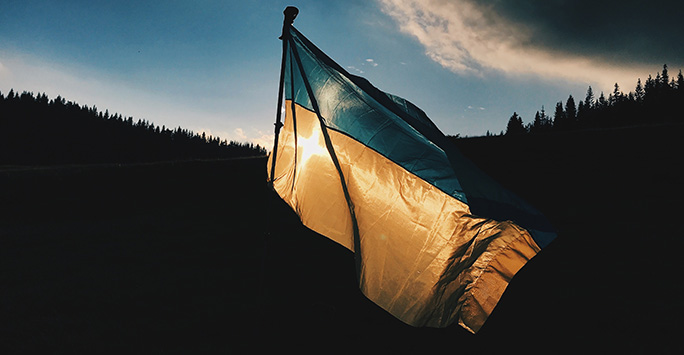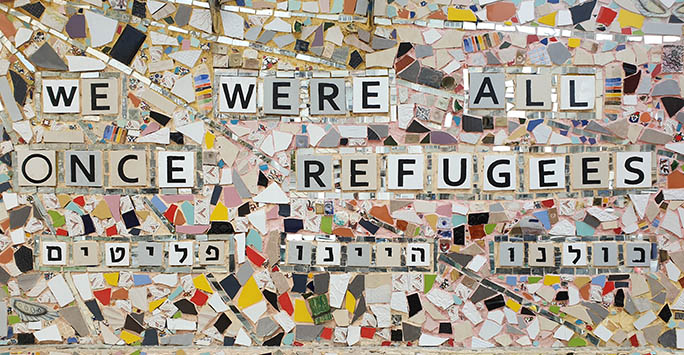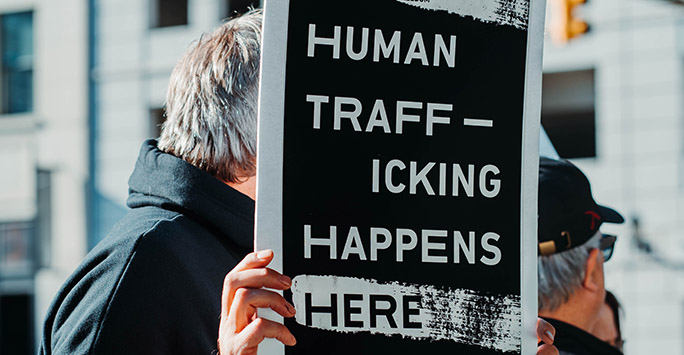Ukrainian Refugees and Modern Slavery
Posted on: 24 May 2022 by Molly Green in Blog

Human trafficking is a form of modern slavery and its often exacerbated by war, as a country becomes inhabitable and those native to said country wish to go somewhere safer. Molly Green, Postgraduate Research Student in the Department of Sociology, Social Policy and Criminology, discusses this issue in relation to the Ukraine crisis.
“For predators and human traffickers, the war in Ukraine is not a tragedy. It’s an opportunity – and women and children are the targets.” – UN Secretary General António Guterres.
When people think about the influx in migration movements, they commonly jump to the conclusion of people smuggling. However, this is usually not the case. With smuggling, there are often ultimatums, vulnerable people being exploited due to unfavourable conditions in their own country, withholding of identifying documents or even dangerous methods of transportation. The lines between smuggling and trafficking are sometimes blurred, however, as soon as threat, deceit or coercion take place, it becomes human trafficking. Human trafficking is a form of modern slavery and is often exacerbated by war, as a country becomes inhabitable and those native to said country wish to go somewhere safer. Traffickers prey on these vulnerable individuals.
Most recently, with the crisis in Ukraine due to conflicts with Russia, Europe and the United Kingdom have seen a sizeable increase in the number of individuals crossing borders. This increase has led to a correlational increase in the number of individuals being trafficked and being subjected to modern slavery. This increase consists mainly of Ukrainian refugees. Due to the recency of this crisis, not much research has been done with regards to numerical statistics. However, the UN has identified that over 11 million people have been forced to flee Ukraine, with the majority of these, around 90%, being women and children.

The International Organisation for Migration (IOM) conducted a survey from 2019 to 2021 which estimated that around 46,000 Ukrainians had been victims of human trafficking. Of these, 18% responded that they would accept an informal and risky job offer abroad. Suggesting that this number would rise once the living conditions in the country were worsened. This has become apparent by the increase in calls that the National Migrant Advice and Counter-Trafficking Hotline has been receiving from Ukraine. This hotline was set up by the IOM in response to the previous survey, and between February 24 and March 16 they received 60% more calls than last year.
Where countries such as the United Kingdom and the Netherlands have anti-trafficking legislation that works against traffickers and NGOs that aim to protect and support victims, not all countries are equipped to deal with modern slavery crimes. Especially not with this accompanying increase in the crimes. An example of this occurred at the end of March, where human rights organisation Homo Faber told BBC journalists that children were a big concern. The Polish-Ukrainian border was seeing children disappear due to inconsistent registration records, and individuals acting as fake volunteers at refugee centres in Romania. Said fake volunteers were trying to persuade women and their children to board vans full of women to be taken to ‘safety in Switzerland’. One woman described her experience with the same fake volunteers, where her son was taken into a separate locked room to herself, and she had to trick the men so she could escape with her children. Another worrying method that traffickers are using as a way of avoiding detection by utilising technology is by purchasing plane tickets for Ukrainian women to Mexico, Turkey, and the UAE. Poland based organisation La Strada have disclosed multiple cases like these, and a current one where they are having to attempt to persuade a 19-year-old from joining her friend at an unknown man’s house. The girl is even aware that the man beats her friend, but then gives her presents and compliments, which is seen as more favourable living conditions than their current war-torn country.
The UNHCR and UNICEF have started working together to set up help desks near the border in Warsaw and Kraków to offer information and services to vulnerable refugees on risks and threats they may face. UNHCR has also been working with the IOM to train volunteers working at borders to make them aware of trafficking risks, including what to do or who to contact if they see the warning signs. Another factor of the training covers some of the core principles of protection from sexual exploitation and abuse in humanitarian work, including the prohibition on asking for anything in exchange for aid.

Most recently on 7th April, the Independent Anti-Slavery Commissioner (IASC) Dame Sara Thornton contributed to a roundtable led by University College of London (UCL) Dr Ella Cockbain and Dr Aiden Sidebottom, with the support of the IASC office. It focused on the war in Ukraine and the associated risks of human trafficking and exploitation in the UK. Specialists such as lawyers, NGOs, academics, civil servants, law enforcement and representatives from the United Nations Office on Drugs and Crime (UNODC), the Organization for Security and Co-operation in Europe, the International Organization for Migration and the Modern Slavery Policy and Evidence Centre took part. These expert talks focused on the emergent issues and risks surrounding trafficking and exploitation in relation to the war in Ukraine, and the implications for responses. Immediate steps needed to prevent the current humanitarian crisis from turning into a human trafficking crisis were covered in depth, alongside troubling gaps in responses, and the importance of establishing long-term, collaborative and trauma-informed approaches to support those settling in the UK. This was completed with the intention of creating a policy-focused report on the issues raised and implications for responses to help guide current and future efforts. The roundtable discussion helped to identify five main themes regarding human trafficking and the Ukraine crisis, which are outlined in the report. These main themes are:
1) Conflict drives human trafficking and exploitation.
2) The UK’s visa-based response to Ukrainian refugees contain risks in terms of human trafficking and exploitation, therefore they need more resourcing and accountability to stop this.
3) Information gaps and overloads may worsen the human trafficking risks, meaning the UK and other countries need clear and accessible support for refugees.
4) The political thoughts and opinions surrounding immigration and asylum worsen the conditions of trafficking response.
5) Longer-term strategic planning is vital but lacking currently. Where there is currently help for Ukrainian refugees, the situation could be long lasting, and the worries of compassion fatigue are present.
From this report, there were a total of 25 policy recommendations, relating to immediate measures that ought to be taken to medium- to long-term responses. These measures focus on ways of reducing risks of human trafficking and exploitation, increasing resilience, and building capacity to respond. From these 25, there are six key aims that lay behind the recommendations:
1) Preventing people from falling through the gaps in current provisions and thus becoming especially vulnerable to human trafficking and exploitation.
2) Improving safeguarding and risk management for those believed to be at especially high risk of human trafficking and exploitation.
3) Thinking more strategically in terms of using information and guidance to address risks of and responses to human trafficking and exploitation.
4) Building resilience and reducing risk to human trafficking and exploitation through access to vital rights, services, and support.
5) Addressing systemic issues that produce and exacerbate risks of human trafficking and exploitation.
6) Other steps towards a more strategic, long-term response to addressing risks of human trafficking and exploitation in conflict situations.
Where this is a step in the right direction for the UK, it is up to the government now to act and take these recommendations on board to make the changes that are vital for the wellbeing of Ukrainian refugees and any future refugees. It is also important that other countries take note of this report and multi-agency response that the UK have carried out, and follow suit, as the UK is not the only country taking in these refugees and the fight against human trafficking requires an internationally united front.
Keywords: Liverpool University Sociology Blog, Sociology blog Liverpool, Ukrainian refugees, Modern slavery, Ukraine war, human trafficking, People smuggling.